Future Technology
Future Technology: New technology that is currently being developed, or will be developed within the next five to ten years.
Here at The Discovery School, we like to prepare children for their future by providing them with a well-rounded education. Future Technology is different in that it looks at the possible technologies, which are emerging that may change the way we look at the world. To prepare them for this exciting new world, our children will get the chance to engage, test and experience these exciting activities. We will share the work and good practice here on this website so come by to check out what exciting and innovative things we are doing! Click on a link below...
Children from across the school are given the chance to record, edit and take part in our termly learning updates.
Visit our learning updates page to see our recent videos.
As a Digital Leaders project, we have been researching about retro gaming systems. We found out about the specs, cost and many other important facts about various systems and then relayed this in podcasts.
Back in the 80’s and early 90’s there was no Playstation 4 or Xbox One, we had the NES, SNES and Megadrive… wonderful machines with great games but the graphics were lacking due to the lack of processing power. To create games, artists used pixel art, using small blocks to create an image similar to mosaics. With so few pixels to work with, pixel artist’s had to make each one count and count they did. There are many iconic images that are ingrained into gamers minds and pop culture as a whole. The recent films, Pixels and Wreck It Ralph, show that there is a lot of nostalgia and love for these old pixelated characters. When teachng the lessons, we were pleasantly surprised by how many of the children could identify the various old-school pixel art computer characters. The children easily identified such icons as Mario, Pacman and Sonic but the more obscure icons such as Donkey Kong were quickly recognised too.
Using an in-browser software piskelapp.com. the children made self-portraits in the pixel art style.
Manga is a Japanese art form and is a popular form of comics and animation. Many children may watch manga without knowing it such as Pokemon, Naruto, One Piece and Dragonball- these are all manga. Manga is a distinctive art style which is usually characterised by big eyes, crazy hair and tiny mouths and noses.
Working with a group of pupils from years 2, 3 and 4 we used an in-browser software to create a mangatar, a manga style avatar of themselves.
Once the children had created the mangatar, we print screened the image and pasted it onto Word and enlarge it so that it fitted an A4 page. Once we had done that. we used small canvases and the children traced around the eye of their character. We then painted the image in bright colours to give it a comic/ Pop Art style. To finish off the work, we went over the lines in a thick black pen and this made the art really stand out.
Animation is a fun way for children to express their ideas through a medium that blends art, storytelling, drawing, illustration, design, graphics, sculpture, acting, staging, art directing and filmmaking into one amazing form capable of transforming its creators into magicians. Animation is unbounded by time or reality. It brings to life visions and ideas that are the artist’s creation, limited only by their imagination. At The Discovery School, we use a fun software called GoAnimate, which is an in-browser that allows you to make simple animations easily and quickly.
Digital Art
Digital Art is an artistic piece of work that uses digital technology to create. With the rise of computing and the internet it is an important skill to learn how to produce art using a variety of digital art platforms.
Arcimboldo and Food Art
We have been working with a group of pupils from year 2, 3 and 4 to discuss the work of the Italian artist Arcimboldo. Arcimboldo was born in Italy in 1527 and was famous for creating portraits using fruits, vegetables and other fruit items. The children used his art as inspiration to make their own artworks.
To make your own fruit face click HERE
At The Discovery School, we have been building upon the coding we do across the school to develop further skills with robotics. We've just bought an OhBot at our school and are underway in using it to help teach programming. For the uninitiated the Ohbot is a robot head that uses a derivative of Scratch. Priced at just over 100 pounds (about $150) it really is a good investment to teach the children coding. The OhBot allows children to generate programs quickly and encourages them to experiment and use their imagination. The OhBot is flexible in that additional sensors can be used to allow for more complex coding. We have yet to fully get to grips with it but will be sharing our work here.
Video games have the ability to engage pupils like no other medium and that is why as part of our work on Kensuke's Kingdom, the adventure novel by Michael Morpurgo, we decided to use PlayStation VR and the video game Perfect to immerse them in detailed rendered representation of a tropical beach. We used the PSVR and connected it onto a projector and sound system. Mr Razaq was controlling the VR headset as it is not recommended for anyone under the age of 12. He held the VR headset in his hand and controlled it in this way so he could still speak to the pupils. He recorded the gameplay using the recording option and uploaded it onto YouTube.com so the children could refer to it whilst they were writing their piece.
At school we purchased a Playstation 4 and a VR headset. The PSVR headset gives a sense of excitement amongst many of the teachers and all of the pupils.
Here at The Discovery School, we hope to use this cutting edge technology as a contextual hub for learning. We’ve spoken before on this page about how video games can be used as an instrument to hang learning on but, with VR, you can immerse the children in the world, they can BE there, in the digital world.
Over the past few weeks, we have been playing and recording a few games, which we feel could be used as a writing stimulus and as a school we will be working diligently to create exciting and fun lesson plans based on these.
With the arrival of the PSVR, the Digital Leaders played the demo disc, which contained several experiences of varying quality, with our Digital Leaders, pupils who are keen and excited by emerging technologies and they were suitably excited.
VR could be an integral part of education and PSVR seems to be one of the most affordable commercial ways to get in on the ground level. Whether the potential is realised remains to be seen, but at our school we'll certainly be giving it a good try!
At our school we have been using the game Abzu as a stimulus for writing. We've spoken before on numerous occasions about how video games can be used as a contextual hub for learning and in the past we have used some games to help on the learning journey.
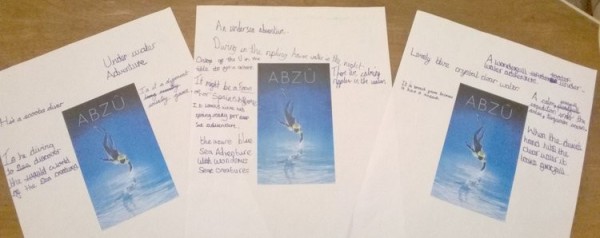
Some of the staff have played and completed Abzu in their own time and enjoyed the experience. The fact that the story line and its meaning were ambiguous, its visual style abstract and its music soothing and dramatic made many feel that this would be a good game with which to engage the pupils. At its core Abzu is a diving game but this is incredibly reductive as in the game most of the time is spent swimming with the myriad of underwater creatures, but it's distinctive visual style of flatter shapes, flowing lines and an expressive use of light and colour make it a unique and exciting experience.
In Abzu, you play a silent diver and explore a strange, underwater realm. In terms of gameplay, it's fairly simple as you swim and interact with a few mysterious objects. Because the game itself has a minimal HUD on screen, all you see are the gorgeous visuals with the natural environments in lush bright colours giving way to mysterious sunken ruins with strange hieroglyphs, which seem readable but for the need of a Rosetta stone equivalent.
But there are no question marks about Abzu's beauty. It's not so much that the individual elements are all that astonishing, but the way they're orchestrated, with the shoals of beautifully animated fish, the slowly undulating vegetation, the areas of coloured light and shadow, regularly takes your breath away. At its best the union of music and visuals can be absolutely magical.
In our lessons we used Abzu to write a descriptive piece of writing. The children were presented with an image of the cover and had to predict what the game was about.
When we started the game the diver is seen to be floating on top of the ocean, motionless and with its eyes closed. With the click of a button the eyes opened and the children gasped in delight as I ascended to the top of the sea, all around there was ocean and glimmers of seaweed in the distance.
We dove down into the waters and children started to note down describing words on their image proforma; azure waters, crystal clear sea, shimmering sparkling waters, refracted light etc. We then gently swam towards a shoal of brightly coloured fish and described their movements and how they reacted when our diver moved near; ruby red fish swam carefree, swishing their tail from side to side, the fish quickly darted away startled as the stranger came near etc We then got the diver to hold onto a giant fish and glided through an opening in the rocks and the children gasped in delight as the dark cave gave way to a bright green seascape full of wonderful creatures; verdant undulating seaweed gently swayed from side to side, shoals of fish swam in tight circles to protect each other etc.
Having played just the first 15 minutes of the game the children were entranced and engaged. They produced wonderful wordbanks of phrases and ideas which they shared made improvements upon.
The children were inspired and then spent the next 30 minutes working in pairs writing and refining their descriptive sentences on their whiteboards and transferring into their paper. The children shared what they had done and constructive feedback was provided by their peers. Once the final piece was checked by a teacher the children wrote up their pieces on Word.
Virtual Reality is Here
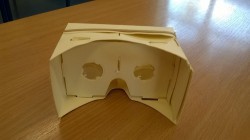 As teachers and educators, we like to immerse our children in topics to interest and excite them. With certain topics this is easy as we have to facilities and resources nearby to engage them, however with certain topics like history or geography, this can be difficult as the places we are discussing are often not within reach.
As teachers and educators, we like to immerse our children in topics to interest and excite them. With certain topics this is easy as we have to facilities and resources nearby to engage them, however with certain topics like history or geography, this can be difficult as the places we are discussing are often not within reach.
How would much more thrilling would it be to stand in the place we are learning about? We can't take our classes on an educational visit to Ancient Egypt, for example, when we are learning about the Pharaohs but what if we could take them there virtually? Well, with the power of Virtual Reality, we can.
We have been introducing VR into the school by getting some children to create Google Cardboard VR headsets. It may not look like much, a simple unassuming little cardboard box but through the use of magnetometers, accelerometers, gyroscopes and external head cameras, which come as standard in most mobile phones, we have the opportunity to transport our children to amazing places.
We made the kits ourselves by using the Brother ScanNCut machine to cut out the Google Cardboard template, buying lenses on amazon.com for 80p a pair and a large pack of magnets for 30p each. The whole cost was less than £1.50 but for this the children had a compete VR headset! For those not used to crafting for about £10, you can buy a cardboard housing for a smartphone running Google's Android mobile OS, a lens kit, some magnets, some velcro and a rubber band and an easily programmable Near-Field Communication sticker tag for launching the companion mobile app.
The cardboard app comes with 7 “experiences”;
- YouTube lets you watch a selection of Youtube videos on a simulated theater screen.
- Street Vue lets you wander around in a VR version of street view.
- Exhibit lets you look at a few 3D recreations of objects.
- Earth Flyover lets you zoom around a city in Google Earth. Push the “button” to start flying forward, push it again to stop.
- Photo Sphere Viewer lets you look around in pictures you’ve taken using Android’s built-in 360º panoramic feature.
- Windy Day is a cute, cartoony environment where you can watch animals sneak around as leaves fall.
- Tour Guide has you explore the Palace of Versailles.
The children loved making their headsets and took it into their classes to show their peers, there was a great buzz as pupils had a chance to immerse themselves in a roller coaster ride. Teachers were excited about the prospect of VR and what implications it could have for their practice.
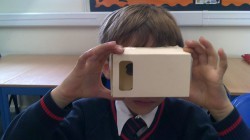 As with any new technology, there needs to be discussion about its implications upon the world. With the emergence of VR there is a real fear that people may become plugged in but may not plug out. We need to ensure we talk to our children about being plugged in all the time- it is a real danger.
As with any new technology, there needs to be discussion about its implications upon the world. With the emergence of VR there is a real fear that people may become plugged in but may not plug out. We need to ensure we talk to our children about being plugged in all the time- it is a real danger.
However on a more positive note, we hope to create a class set of VR headsets and with the use of devices download many useful apps which could be used across the curriculum.
In the past, we got a few of our students together to create a smartphone projector. We ordered the parts required and over the course of a lunchtime, we created our projectors. The process was cheap and simple. To make the shoebox projector all we needed were:
- Scissors
- Tape
- Shoebox
- Cardboard
- Magnifying Glass
- A smart phone
The most difficult aspect of the whole process was the cutting out the circular shape for the magnifying glass, as the shoe boxes were quite thick. However it was worth the effort as the results were excellent. It required a bit of tweaking to get the image clear but overall the result was well worth the 45 or so minutes it took to create a final piece. I'd recommend you use a very strong magnifying glass as this will dictate the quality of the image. If you have a spare hour or so why not try it yourself? (please ask your adult helper for assistance with any cutting of cardboard as it is quite difficult to cut).
As an interactive medium, video games can be an amazing teaching tool off which to hang learning. They have the ability to engage pupils in a way that other mediums like books and films can't as the games can simulate and adapt to the decisions of the individuals, if we want to go left we can go left! We are delighted to be using the PlayStation VR we have purchased at school to help us engage and immerse our pupils in the world of 'Kensuke's Kingdom', the adventure story by Michael Morpurgo. We thought that the most appropriate use of the technology would be to describe the setting when the protagonist, a young boy called Michael, wakes up on the shore of a beach after falling overboard his family's yacht after a storm.
We purchased the application 'Perfect' for the Playstation VR, which immerses you in detailed rendered worlds and hope that this will encourage the pupils to write wonderfully detailed descriptions about the deserted beach setting. Year 4 used the software to write a descriptive piece and below are the stimulus we used and the writing outcome.
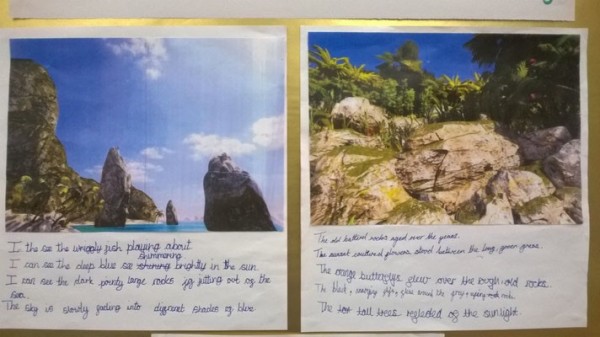
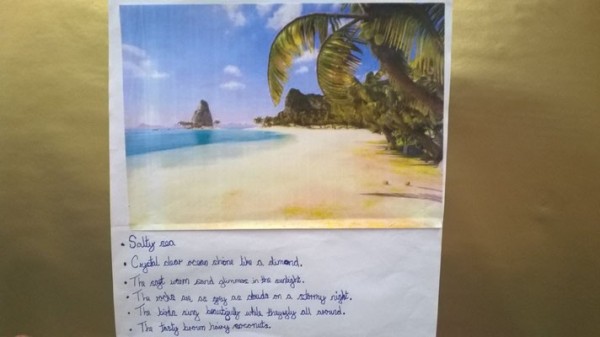
As a teacher and an avid gamer, Mr Razaq (Archimedes' Former Teacher) liked to have the children excited and in awe of what he taught. There are many tools out there but video games are a great way to immerse children. So in the spirit of engaging and exciting the children, Year 4 used one of their favourite games, which had an exciting and intriguing introduction, as a story writing stimulus. Year 4 staff planned a sequence of lessons with the intention of getting the children to develop their vocabulary, specifically their use of adjectives and adverbs. The lessons took place over the course of a week and a half. To get them into the right frame of mind, they listened to the ambient soundtrack, watched the play-through of the first few minutes of the game and wrote the story in draft and then typed and illustrated it. We converted the finished files into the pdf format so parents could put it on their Kindle, ipads, iphones etc and read them on the go. Here are the stories the children wrote:
Story of the Colossus by Harry F
The Long Journey to the Truth by Georgia
The Mysteries of the Colossus by Callum
The Shadow of the Mighty Colossus by Nana
The Story of the Colossus by Summer
The Mysterious Land by Daniella
The Mystery of The Colossus Land by Oliver
The Witch's Potion by Baileigh
Drones are everywhere. In the past couple of years the commercial availability of drones has risen whilst their prices have dropped. This has led to this past year being the Year of the Drone, with the gadget high on many people's Christmas list. In the past year, many of our pupils have been bought drones.
In the past year, there has been a huge amount of interest shown in drone racing as a sport, with the Drone Racing League, the National Drone Racing Championships and the Dubai World Drone Prix forming. In fact, the Dubai World Drone Prix had a prize winning pot of $1 million, a record for the fledgling sport, which was won by a British 'pilot'.
As teachers, we should encourage our pupils to take part in whatever interests them, and so in this spirit, our school purchased 3 Hubsan X4 H107C to develop their basic piloting skills, 2 Hubsan X4 Mini FPV to develop their first person flying skills, 2 Boblov Eachine FPV flight goggles and a few air-gates to practise our skills.
Our Digital Leaders have been looking through the resources and have helped to plan a sequence of lessons with the intention of starting our own Drone Racing League, potentially starting an inter-school competition in the near future.
For those unaware of FPV Drone flying, the process involves flying drones whilst wearing FPV (First Person View) googles. It is an unsettling, dreamlike experience but once you get used to it, it truly an immersive and engaging experience.
Our hope is that should drone sports take off, we are providing our pupils with the resources and skills needed to compete in the sport and maybe create future pilots. We will be sharing our experiences right here at the Discovery Future Technology site.
